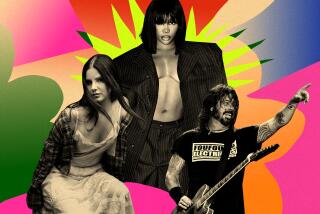Music doesn’t get more current than ‘Now’
- Share via
Today’s music charts contain the past, glimpses of the future and the ephemeral glitter and detritus of right now. And there’s one compilation series, at once old-fashioned and progressive, that tries to encapsulate it all.
The Beatles, whom Timothy Leary once called “mutants … with the power to create a new human species,” are still the all-time bestsellers of the Billboard 200 chart, with 19 No. 1 albums. The next artist after the Beatles is the rapper-mogul Jay-Z, with 12 albums. But nipping at the heels of the mop-topped harbingers is a throwback phenomenon known as “Now That’s What I Call Music!,” a series of compilation CDs released four times a year, an ever-shifting fingerprint of the corporate musical body.
“NOW” is a little like “The Grey Album,” Danger Mouse’s mash-up of Jay-Z and the Beatles, but this mix tape samples the majority of popular radio: the monster R&B ballad, the runaway country crossover, the one-hit wonder from YouTube, the latest synthesized blast from the dance club. Indeed, “Now” suggests that for all the options for discovering what’s new – Spotify, SoundCloud, satellite radio – there’s a sizable mainstream audience that desires guidance.
Since the U.S. version started in 1998, copying its formula from the massively successful “Now” U.K. franchise, the series has lobbed 15 albums into the top position even if the title all but begs for a cheesy sales guy to announce it while finger-shooting directly at the TV camera. It doesn’t help that the CD covers, often adorned with rocket ships, balloons or pinwheels, look like party favors left over from 1989, but that old-fashioned packaging is part of the mall-spun charm. “Now” is proudly of and for the people. A narrow, numbers-driven definition of popularity is its only currency; for better or worse, “Now” reflects the preferences of the mass listening public back at itself.
America apparently likes what it sees and hears in the mirror: More than 80 million copies have sold in the U.S. Last week, “Now” celebrated its 40th release with a deluxe two-CD package with twice the regular allotment of hits, in addition to the usual single-disc version.
Jeff Moskow, the head of A&R for “Now,” which is a joint venture between EMI Music North America, Sony Music Entertainment and Universal Music Group, calls each compilation a snapshot of the current landscape of American pop music, one that is laser-focused on the top.
“It’s called ‘Now,’ not yesterday,” Moskow said from his Los Angeles office. “It needs to be extremely competitive.” Formulating the track list a couple of months before the release, based on various charts from Billboard, YouTube and iTunes, Moskow adds and drops songs up to a month before. “It comes down to a slugfest at the end.”
Those lucky singles that make it, according to marketing surveys commissioned by “Now,” spur 70% of compilation listeners to buy more music from the artist.
Jeremy Wallach, chair of the Popular Music Section of the Society of Ethnomusicology at Bowling Green State University, points out that “Now,” despite enjoying robust sales, is also somewhat stigmatized in the U.S., unlike in Europe or Asia, where compilation CDs are more prevalent. “We put such a premium on individual choice in this country,” he said, “yet with all the choices we have it’s nice to have some things chosen for us” — as with Oprah’s Book Club, the record clubs of yore and “American Idol.”
A former Philadelphia club DJ, Moskow aims to make the switch from genre to genre as seamless as possible. Test-driving several possibilities in the studio, he sequences each compilation “to take the audience on a journey that starts with a high sense of drama.” The CDs barely let a second of silence lapse between radio fodder from the likes of Katy Perry, Rihanna, Selena Gomez, Bruno Mars or Blake Shelton.
Jordan Feldstein, manager of Maroon 5, a frequent “Now” artist whose fast-rising track “Moves Like Jagger” is the buoyant kickoff for “Now 40,” said the “Now” CDs reflect the omnivorous ways we consume music. “Kids have Christina Aguilera, AC/DC, Lil Wayne and Nickelback on their iPods. The fact that Lil Wayne was on a Jonas Brothers track,” Feldstein said, referring to the remix of Joe Jonas’ single, “Just in Love,” “that’s the kind of collaboration I couldn’t have imagined 10 or 15 years ago.”
But for all its genre mixing, “Now” is in many ways a quaint relic. Though “Now” has been available digitally for the last six years, more than 90% of sales for the last four compilations, according to SoundScan, have been through physical CDs, available at Target, Best Buy and Walmart. The series’ aggressive marketing also targets classic avenues, including TV and radio spots.
It might be that unabashed embrace of populism that puts some artists off. Moskow said that “90% of artists are enthusiastic, but every once in a while we encounter an artist, label or manager who has concerns about certain songs” and they decline licensing to “Now.” He declined to mention any specific artists.
Curiously, even the musicians who have appeared regularly on “Now” don’t seem especially willing to talk about the experience. Several of them turned down or didn’t respond to interview requests, with a few band publicists openly dismissing the product as a death knell for good taste.
Patrick Stump, the lead singer for Fall Out Boy, whose pop-punk confections have appeared on three of the compilations, has encountered that reaction firsthand. “There’s still this pervasive idea in rock music that if your music becomes popular, somehow it’s less real,” said Stump, who recently released his R&B-inflected solo debut. “I think it’s pretentious and backwards. But I’d hear from punk-rock friends and even audience members that it was lame to be on ‘Now.’”
If certain factions of rock don’t want to be seen on a “Now” collection, dance music is more than happy to take its place, alongside the compilations’ steady diet of tween bop. In the last year, Moskow says he’s seen rock increasingly usurped by club bangers, despite cornerstone “Now” artists such as Nickelback.
Perhaps the rock snobbery toward “Now” boils down to its audience. According to Laura Rutherford, vice president of “Now” marketing and operations, the series appeals most to kids in the 9-to-15 range. “They’re just discovering pop for themselves,” Rutherford said. “They like to collect every album in the series.”
The uniting force of the “Now” CDs might be popularity, but it’s also a utopian sense of community, the American dream of everyone finding where they belong. “These songs are like ambassadors from one genre representing one type of person to another genre representing another type of person,” Wallach said. “It’s a place where all these different kinds of music can peacefully coexist. It might be the idealistic version of itself that America wants to see.”
More to Read
The biggest entertainment stories
Get our big stories about Hollywood, film, television, music, arts, culture and more right in your inbox as soon as they publish.
You may occasionally receive promotional content from the Los Angeles Times.










